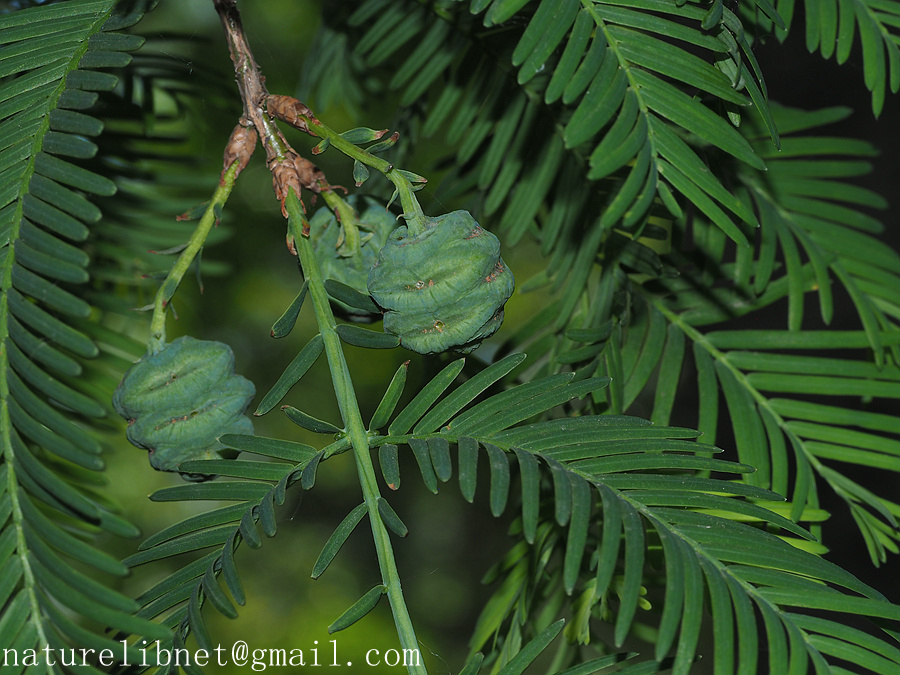- Scientific Name: Metasequoia glyptostroboides Hu & W.C.Cheng
- Ref: Bull. Fan Mem. Inst. Biol., n.s., 1:154. 1948
- Synonyms:
- Metasequoia glyptostroboides var. caespitosa Y.H.Long & Y.Wu
- M. glyptostroboides subsp. caespitosa (Y.H.Long & Y.Wu) Silba
- M. glyptostroboides subsp. neopangaea (Silba) Silba
- M. honshuenensis Silba & Callahan
- M. neopangaea Silba
- Sequoia glyptostroboides (Hu & W.C.Cheng) Weide
- English Common Name: dawn redwood
- Chinese Common Name: 水杉 shuǐshān
- Japanese Common Name: メタセコイア metasekoia, アケボノスギ [曙杉] akebonosugi, イチイヒノキ [一位檜] ichiihinoki
- Family: Cupressaceae
- Genus: Metasequoia
- Distribution: Riparian habitats on valley floors and in moist ravine bottoms, on acidic, montane yellow-earth soils in regions with moderate climate. A rare species as a native plant because the valley floors are now largely under rice cultivation. Also widely cultivated as an ornamental or planted for afforestation in Anhui, Fujian, Guangdong, Guangxi, Guizhou, Hebei, Henan, Hubei, Hunan, Jiangsu, Jiangxi, Liaoning, Shaanxi, Shandong, Shanxi, Sichuan, Yunnan, Zhejiang.
- Photo: 08/05/2013
- Note: Metasequoia fossil from Miocene is the official state fossil of Oregon, USA.
Trees to 50 m tall; trunk buttressed at base, to 2.5 m d.b.h.; bark of young trees pale orange-brown with darker flakes and exfoliating, finally dark reddish brown to gray, fissured; crown narrowly conical or pyramidal, finally broadly conical; branches ascending; branchlets pendulous, axis pinkish green or pale purple in 1st year, later brownish gray; winter buds to 5 × 3 mm, apex obtuse, scales yellowish brown, ca. 2-2.5 × 2-2.5 mm. Lateral branchlets deciduous, opposite, each subtended by leaflike scale, with longer and shorter leaves alternating irregularly, forming an ovate-elliptic outline 3-7 × 1.5-4 cm. Leaves borne at 45-60° to branchlet axis, 2-5 mm apart, bluish green or yellowish green adaxially, paler abaxially, turning orange or red in autumn, linear, 0.8-1.5 cm × 1.2-2 mm on old trees but longer on younger trees, stomatal hands 0.4-0.6 mm, indistinct, marginal bands 0.5-0.6 mm wide, apex obtuse or with hyaline mucro, more sharply acute on leaves of leader branchlets. Pollen cones ovoid, 2.5-5.5 × 2-3.8 mm; bracts triangular-ovate or obovate, ca. 4 × 3 mm, lowest minutely ciliate distally, others glabrous. Seed cones purplish black when young, oblong-ellipsoid and to 9 × 5.5 mm at pollination, subglobose and 1.4-2.5 × 1.6-2.3 cm when mature; basal cone scales 9-ovulate, middle 7-ovulate, distal 5-ovulate, apical sterile. Seeds ca. 5 × 4 mm. Pollination Feb-Mar, before leaves, seed maturity Oct-Nov. (Flora of China)
